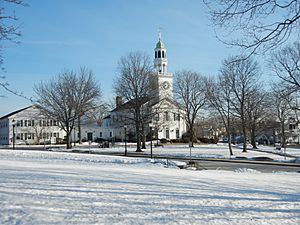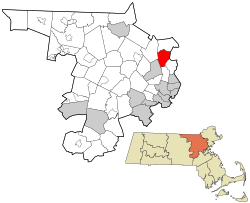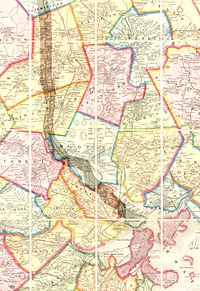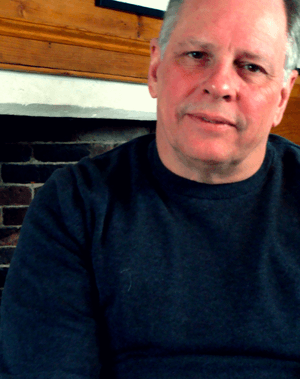Reading, Massachusetts facts for kids
Quick facts for kids
Reading, Massachusetts
|
||
|---|---|---|

Downtown Reading in March 2014
|
||
|
||

Location of Reading in Middlesex County, Massachusetts (left) and of Middlesex County in Massachusetts (right)
|
||
| Country | United States | |
| State | Massachusetts | |
| County | Middlesex | |
| Settled | 1644 | |
| Named for | Reading, England | |
| Government | ||
| • Type | Representative town meeting | |
| Area | ||
| • Total | 9.9 sq mi (25.7 km2) | |
| • Land | 9.9 sq mi (25.7 km2) | |
| • Water | 0.0 sq mi (0.0 km2) | |
| Elevation | 127 ft (39 m) | |
| Population
(2020)
|
||
| • Total | 25,518 | |
| • Density | 2,578/sq mi (992.9/km2) | |
| Time zone | UTC-5 (Eastern) | |
| • Summer (DST) | UTC-4 (Eastern) | |
| ZIP Code |
01867
|
|
| Area code(s) | 339 / 781 | |
| FIPS code | 25-56130 | |
| GNIS feature ID | 0618232 | |
| Website | http://www.ci.reading.ma.us/ | |
Reading is a town in Middlesex County, Massachusetts, United States. It's about 16 miles (25.7 km) north of central Boston. In 2020, about 25,518 people lived here.
Contents
History of Reading
Early Settlement and Independence
Many of the first settlers in the Massachusetts Bay Colony came from England in the 1630s. They arrived through ports like Lynn and Salem. In 1639, some people from Lynn asked for land to start a new town inland. They were given ten square miles.
The first settlement was called "Lynn Village." It was located on the south shore of "Great Pond," which is now Lake Quannapowitt. On June 10, 1644, the settlement became an official town called Reading. It was named after the town of Reading in England.
The first church was started soon after the town was settled. In 1812, part of Reading became a separate town called "South Reading." This town later changed its name to Wakefield in 1868. Thomas Parker was one of the founders of Reading. He helped start the First Parish Congregational Church and was a town leader. He likely helped name the town.
In 1651, more land was added to Reading, north of the Ipswich River. In 1853, this area became the separate town of North Reading. The area that is Reading today was once known as "Wood End."

Reading was first run by an open town meeting and a board of selectmen. This system lasted until the 1940s. In 1693, the town decided to pay for public education. They set aside money for schools in different parts of town. In 1769, the town meeting house was built. A stone marker now shows where it stood.
Reading played an important part in the American Revolutionary War. The town was involved in chasing the British Army after the battles of Lexington and Concord. John Brooks, who later became Governor of Massachusetts, led a company of "Minute Men." He also fought in other battles. Only one soldier from Reading died in the Revolution.
In 1791, sixty people started the Federal Library. Members paid a small fee to join and annual dues. The town's public library was created in 1868.
Reading in the 1800s
The Andover-Medford Turnpike was built in 1806-1807. This road, now called Massachusetts Route 28, made it easier for people in Reading to travel to Boston. In 1845, the Boston and Maine Railroad came to Reading. This greatly improved travel and trade with Boston.
During the early 1800s, Reading became a town known for manufacturing. Factories made furniture, clocks, and organ pipes. By the mid-1800s, Reading had many factories making chairs and cabinets. The making of shoes also grew from small home businesses to large factories. Neckties were made here for about ninety years. After the Civil War, many factories closed because they lost their markets in the South. For many years, Reading was also a major center for making caskets.
During the Civil War, many men from Reading joined the fight. A total of 411 men from Reading fought. Sadly, 15 died in battle, and 33 died from injuries or sickness. There is a memorial in Laurel Hill Cemetery for those who died in the Civil War.
Reading in the 1900s
In the 1900s, Reading became a town where people lived and traveled to work in Boston. They used the Boston and Maine Railroad and the Eastern Massachusetts Street Railway. These services were later taken over by the Massachusetts Bay Transportation Authority (MBTA). There were talks about extending the MBTA Orange Line subway to Reading.
New businesses came to town after World War I. These included the Boston Stove Foundry and Addison-Wesley Publishing. For many years, Wes Parker's Fried Clams was a famous restaurant near Route 128.
Military bases also came to Reading. There were two Nike missile sites and Camp Curtis Guild, a training center for the National Guard. Today, Reading has many shops and service businesses downtown. It also has commercial businesses on Walker's Brook Road.
In 1944, Reading changed its local government. It adopted a representative town meeting system. This meant that a smaller group of elected officials made decisions. A town manager was hired to handle the daily operations of the town government.
Basketball player Bill Russell lived in Reading in the 1960s. He later moved. In recent years, Reading has worked on building a new elementary school. It also renovated Reading Memorial High School, which was first opened in 1954. The high school renovation was finished in 2007.
Geography of Reading
Reading is located at 42°31′33″N 71°6′35″W / 42.52583°N 71.10972°W. The town covers about 9.9 square miles (25.7 km²). There isn't much land covered by water, but there are many small, temporary ponds called vernal pools in conservation areas.
Reading shares borders with several other towns. These include Woburn, Stoneham, Wakefield, Lynnfield, North Reading, and Wilmington.
Population and People
| Historical population | ||
|---|---|---|
| Year | Pop. | ±% |
| 1850 | 3,108 | — |
| 1860 | 2,662 | −14.4% |
| 1870 | 2,664 | +0.1% |
| 1880 | 3,181 | +19.4% |
| 1890 | 4,088 | +28.5% |
| 1900 | 4,969 | +21.6% |
| 1910 | 5,818 | +17.1% |
| 1920 | 7,439 | +27.9% |
| 1930 | 9,767 | +31.3% |
| 1940 | 10,866 | +11.3% |
| 1950 | 14,006 | +28.9% |
| 1960 | 19,259 | +37.5% |
| 1970 | 22,539 | +17.0% |
| 1980 | 22,678 | +0.6% |
| 1990 | 22,539 | −0.6% |
| 2000 | 23,708 | +5.2% |
| 2010 | 24,747 | +4.4% |
| 2020 | 25,518 | +3.1% |
| 2022* | 25,205 | −1.2% |
| * = population estimate. Source: United States Census records and Population Estimates Program data. |
||
In 2010, there were 24,747 people living in Reading. There were 9,617 households. About 36.7% of households had children under 18. Most households (63.5%) were married couples.
The population included people of different ages. About 26.3% were under 18. The average age was 39 years old. In 2015, the average income for a household in Reading was about $107,654.
Climate in Reading
| Climate data for Reading, Massachusetts (1990–2019 normals, extremes 1960-2019) | |||||||||||||
|---|---|---|---|---|---|---|---|---|---|---|---|---|---|
| Month | Jan | Feb | Mar | Apr | May | Jun | Jul | Aug | Sep | Oct | Nov | Dec | Year |
| Record high °F (°C) | 71 (22) |
76 (24) |
92 (33) |
94 (34) |
95 (35) |
96 (36) |
99 (37) |
105 (41) |
95 (35) |
89 (32) |
80 (27) |
78 (26) |
105 (41) |
| Mean maximum °F (°C) | 57 (14) |
58 (14) |
68 (20) |
83 (28) |
89 (32) |
91 (33) |
94 (34) |
91 (33) |
88 (31) |
79 (26) |
71 (22) |
61 (16) |
95 (35) |
| Mean daily maximum °F (°C) | 36.1 (2.3) |
38.8 (3.8) |
46.2 (7.9) |
58.6 (14.8) |
68.4 (20.2) |
76.5 (24.7) |
82.1 (27.8) |
80.5 (26.9) |
73.1 (22.8) |
62.0 (16.7) |
51.6 (10.9) |
41.3 (5.2) |
59.5 (15.3) |
| Daily mean °F (°C) | 27.2 (−2.7) |
29.2 (−1.6) |
36.4 (2.4) |
47.6 (8.7) |
57.5 (14.2) |
66.4 (19.1) |
72.3 (22.4) |
70.8 (21.6) |
63.1 (17.3) |
52.0 (11.1) |
42.0 (5.6) |
32.8 (0.4) |
49.7 (9.8) |
| Mean daily minimum °F (°C) | 18.4 (−7.6) |
19.7 (−6.8) |
26.7 (−2.9) |
36.5 (2.5) |
46.6 (8.1) |
56.3 (13.5) |
62.4 (16.9) |
61.2 (16.2) |
53.1 (11.7) |
41.9 (5.5) |
32.4 (0.2) |
24.3 (−4.3) |
39.9 (4.4) |
| Mean minimum °F (°C) | 0 (−18) |
2 (−17) |
9 (−13) |
25 (−4) |
34 (1) |
44 (7) |
52 (11) |
50 (10) |
38 (3) |
28 (−2) |
18 (−8) |
8 (−13) |
−3 (−19) |
| Record low °F (°C) | −21 (−29) |
−15 (−26) |
−9 (−23) |
13 (−11) |
25 (−4) |
33 (1) |
41 (5) |
32 (0) |
26 (−3) |
16 (−9) |
−2 (−19) |
−14 (−26) |
−21 (−29) |
| Average precipitation inches (mm) | 3.94 (100) |
3.68 (93) |
4.80 (122) |
4.34 (110) |
3.96 (101) |
4.15 (105) |
4.09 (104) |
3.91 (99) |
3.92 (100) |
4.91 (125) |
3.90 (99) |
4.82 (122) |
49.96 (1,269) |
| Average snowfall inches (cm) | 17.1 (43) |
16.3 (41) |
13.0 (33) |
2.1 (5.3) |
0 (0) |
0 (0) |
0 (0) |
0 (0) |
0 (0) |
0.1 (0.25) |
1.9 (4.8) |
12.4 (31) |
61.7 (157) |
| Average extreme snow depth inches (cm) | 10 (25) |
11 (28) |
9 (23) |
1 (2.5) |
0 (0) |
0 (0) |
0 (0) |
0 (0) |
0 (0) |
0 (0) |
1 (2.5) |
7 (18) |
16 (41) |
| Average precipitation days (≥ 0.01 in) | 12 | 11 | 13 | 13 | 13 | 12 | 11 | 9 | 10 | 11 | 11 | 13 | 137 |
| Average snowy days (≥ 0.1 in) | 8 | 7 | 6 | 1 | 0 | 0 | 0 | 0 | 0 | 0 | 1 | 5 | 28 |
| Source: NOAA | |||||||||||||
In Reading, Massachusetts, temperatures usually drop below 50°F (10°C) for about 195 days each year. The town gets a lot of rain, about 44.3 inches (112.5 cm) per year. Snow covers the ground for about 62 days a year.
Getting Around Reading
Reading is located near the highways Interstate 93 and Interstate 95/Massachusetts Route 128. These roads are north of Boston. I-93 goes directly south to central Boston. I-95/128 goes around Boston to the west.
Reading has a train station called Reading station. It's on the Massachusetts Bay Transportation Authority's Haverhill/Reading commuter rail line. This train line connects the town to Boston's North Station. There were once plans to extend the Orange Line subway to Reading.
Reading also has MBTA bus services. Routes 136 and 137 run between Reading station and Malden station.
Schools in Reading
Reading has a public school system called Reading Public Schools. It includes:
- Reading Memorial High School
- Coolidge Middle School
- Walter S. Parker Middle School
- A. M. Barrows Elementary School
- Birch Meadow Elementary School
- Joshua Eaton Elementary School
- JW Killam Elementary School
- Wood End Elementary School
Austin Preparatory School is a private school in Reading. It is for students in grades 6–12. The school is on 55 acres of land and has about 700 students.
Fun Places to Visit
- The Parker Tavern is the oldest building in Reading, built in 1694. It is now a museum.
- The roof of the St. Athanasius Parish church is very unique. It is one of the largest hyperbolic paraboloids in the Western Hemisphere.
- The Burbank Arena skating rink and private condos on Bear Hill Street are built on old Army National Guard missile sites.
- The Stephen Hall House is a historic building listed on the National Register of Historic Places.
- The Capt. Nathaniel Parker Red House is also on the National Register of Historic Places. It was once the town's tavern and a meeting place during the American Revolution.
- The Walnut Street School is a historic building. It is now home to a local community theatre.
Local News and Media
- The Daily Times Chronicle publishes a newspaper for Reading on weekdays.
- The Reading Advocate newspaper is published weekly and delivered by mail.
- RCTV is Reading's Community Access Television station. It allows residents to create and show their own TV programs.
Famous People from Reading
- Jess Brallier, a well-known publisher and author.
- James Cerretani, a professional tennis player.
- Clarence DeMar, who won the Boston Marathon seven times.
- John Doherty, a Major League Baseball player.
- Mark Erelli, a folk musician.
- William M. Fowler, a U.S. naval historian and professor.
- Fred Foy, a famous radio and television announcer.
- John Hart, a surgeon during the American Revolution.
- Danny McBride, lead guitarist for the band Sha Na Na.
- Lennie Merullo, a professional baseball player and scout.
- Moses Nichols, an officer during the American Revolutionary War.
- Thomas Parker, one of the founders of Reading.
- Eddie Peabody, a banjo player.
- Chris Pizzotti, a former football quarterback.
- Bill Russell, a famous basketball player for the Boston Celtics.
- Matt Siegel, a radio disc jockey.
- Tom Silva, a general contractor from This Old House on PBS.
- Cousin Stizz, a rapper.
- Mollie Sweetser, an American politician.
- Jonathan Temple, a landowner and politician in Los Angeles.
- William Weston, a Vermont politician.
- Brad Whitford, guitarist for the band Aerosmith.
See also
 In Spanish: Reading (Massachusetts) para niños
In Spanish: Reading (Massachusetts) para niños






